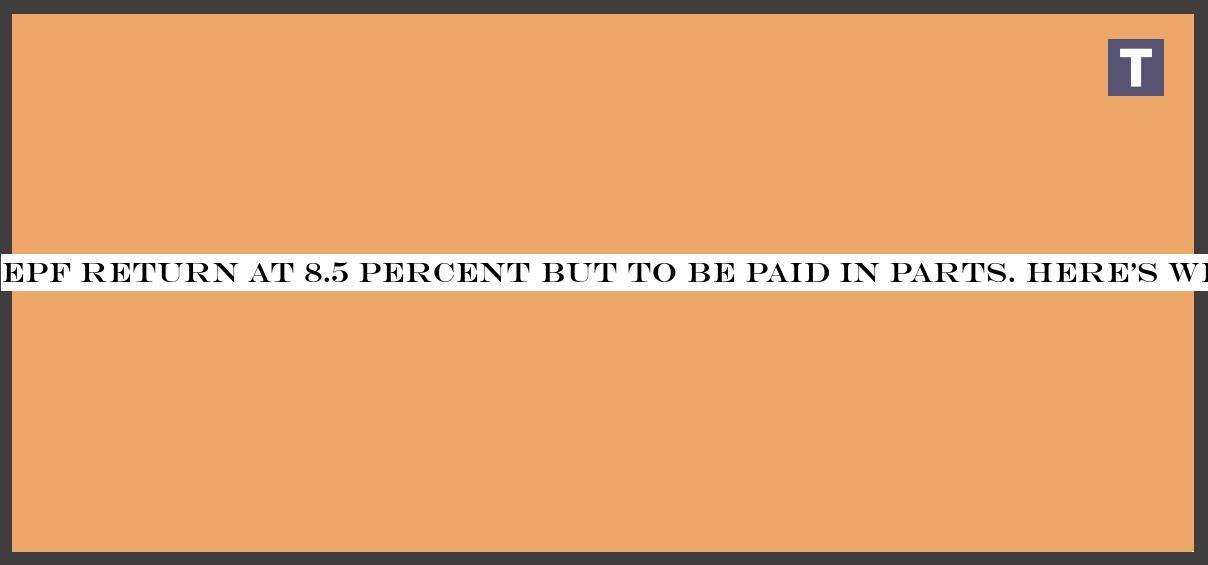
EPFO Interest Rate: The interest rate for 2019-20 has been maintained at the existing 8.5%Your Employees' Provident Fund (EPF) corpus will fetch a return of 8.5 per cent this year.
This is same as the interest rate paid for financial year 2018-19, however, the return this year will be paid in parts.
Retirement fund body EPFO or Employees' Provident Fund Organisation's top decision making body, the Central Board of Trustees, has where on hand kept the rate of return at the existing level, it has divided the payment of interest into two instalments, equivalent to 8.15 per cent and 0.35 per cent.According to the official statement, the 8.15 per cent return will be paid using debt income, whereas the remaining 0.35 per cent will be cleared using proceeds from the sale of ETFs or exchange-traded funds "subject to their redemption by 31st December".That has left many wondering whether the remainder, being linked to equity markets, is guaranteed.(Read More Here: You'll Get 8.5% Interest On Provident Fund - But In 2 Tranches)The provident fund bond will pay the majority of return upfront, which is based on guaranteed instruments, and although the government has assured an overall rate of return of 8.5 per cent for the year, the remainder is based on ETF-linked redemption.The government has said that the splitting of interest payment is mainly on account of liquidity issues arising out of the coronavirus pandemic-related situation.
The EPFO's intent to liquidate some of its investment to meet the shortfall to pay the subscribers has been delayed due to volatility in markets over past few months, in tandem with the COVID-19-triggered turmoil in global equities.What it means is that EPFO plans to clear the dues, or the 0.35 per cent part of your EPFO return this year, by December 31 once it liquidates certain ETF investments."This announcement has left many investors puzzled, however we believe that there is no need to panic as the government has already committed to honour its decision of paying a total of 8.5 per cent interest," Rahul Agarwal, director of Delhi-based Wealth Discovery, a financial services firm, told TheIndianSubcontinent."EPF is a longer-term investment; therefore the credit of interest payments in multiple instalments does not make a huge difference," he added.However, some say the ratification of this recommendation by the finance ministry may bring some clarity on this aspect."If the recommendation is accepted as it is then 0.35 per cent may become contingent in nature because its outcome will depend on the value EPFO fetches on redemption of ETF.
In that event, 0.35 per cent may be received or may not, and guaranteed interest will be only 8.15 per cent," said Gopal Bohra, partner at NA Shah Associates LLP, A Mumbai-based professional services firm.What are ETFs?An ETF or exchange-traded fund is a financial instrument linked to a basket of equities, similar to an index.
But contrary to a mutual fund, in which the price is settled only once every day, the price of an ETF keeps changing throughout a session, similar to a stock or a stock index, such as Nifty.While retirement fund body EPFO has been investing in ETFs since August 2015, it has gradually increased its allocation of investible deposits from the initial 5 per cent, to 10 per cent in 2016-17, and 15 per cent in 2017-18.
And it invests in ETFs based on indicators such as equity benchmarks Sensex and Nifty 50.Experts say EPF continues to be one of an effective tools for the salaried to accumulate their savings for retirement."In the context of the interest rate environment, even the 8.15 per cent interest rate is very high Ideally, the fund should pay for itself and the rate should be kept at 8.15 per cent only," said Sandip Sabharwal, a Mumbai-basedinvestment advisor and fund manager."I am sure no one will be unhappy at this rate," he said.Echoing similar views, Mr Agarwal said: "From a return on investment point of view, EPF returns are one of the highest in the current market scenario, where the returns on fixed income securities and other safe investment opportunities are languishing around 5-6 per cent."

 19
19







